Arthur Parsey’s treatise Perspective Rectified; or the Principles and Application Demonstrated (1836), which offered an alternative to traditional ways of constructing perspectival vanishing points, was reportedly received with much enthusiasm by the artist John Constable. At least this is what Parsey claimed in the revised edition of the work, which was published in 1840.1 The first part of the new edition’s title – The Science of Vision, or, Natural Perspective! Containing the True Language of the Eye – underscored the treatise’s scientific aspirations.2 Parsey was a writer, mathematician and enterprising painter of miniatures who released a well-received treatise on miniature painting in 1831.3 Although his claim in 1832 to have found the solution to squaring the circle was merely laughed at by professional mathematicians,4 Parsey held lectures intensively in the 1830s to convince the public of the soundness of his new ideas on perspective, which were received with some controversy. A polemical debate on the matter began in 1837 in the Architectural Magazine, with criticism by John Ruskin writing under the pseudonym of ‘Kata Phusin’, and continued on into the following year.5 However, it seems that Parsey was able to convince several Royal Academy artists, among them William Etty and Constable, of the significance of his ‘natural perspective’.6 It is possible that they might have been interested in Parsey’s investigation into ‘accommodation’ – that is, the ability of the eye to adjust its focus on objects at varying distances and see them clearly. This aspect of Parsey’s treatise has been largely overlooked in research on his work to date, and will be the focus of this essay.7
In Parsey’s The Science of Vision, Constable is cited as an authority for the correctness of the new method of representation, which, according to the title, articulates the ‘true language of the eye’. Parsey refers to the drawing frame that Constable, who had died three years earlier in 1837, had employed, and explains in great detail how it was to be utilised and what its advantages were:
When he was studying the art of painting in his native place, unaided by others, that he might not introduce too much foreground, and that he might sketch the view correctly, he had attached to the upper part of his easel a frame with a pane of glass in it; this frame was attached by two screw nuts by the two upper corners; to the four corners he attached four strings, which he brought to his mouth in such a manner as to bring the centre of the glass perpendicular to his eye. On this glass, thus held and secured from shifting by fixing the screw nuts, he traced with colour the outline of the view he decided on representing. From this sketch he made his painting and of course his drawing must have been true.8
This report is fascinating, especially in its emphasis on the artist’s ability to adjust the pane of glass that framed his view, tilting it forward or back so as to control how much of the sky or ground he included in his scene. Tilted or inclined planes of vision played a central role in Parsey’s geometric model of the accommodation of the eye, and his observations here suggest Constable experimented with them. The screw-and-nut mechanism with which Constable purportedly fastened the drawing frame to his easel positioned the pane of glass perpendicular to the artist’s line of sight. In this way, the optical axis – the line or path along which light enters the eye – was secured orthogonally (at a right angle) to the glass pane, even if the artist moved his head a little upward or downward. Whereas conventional treatises of perspective addressing artists usually avoided horizontal tilt by advising them to fix both picture plane and artist’s eye orthogonally to the ground, Constable’s adjustable frame enabled the painter to investigate views independently of this static and rigid conceptualisation of space.9
After Constable was accepted as a painting student at the Royal Academy in 1799, he adhered to conventional uses of perspective. However, Parsey suggests that he regretted this in retrospect, presuming that Constable was not aware of the principle behind his framed glass panel during the period in which he used it. He conjectured that Constable had not understood the basic mechanisms underlying his drawing frame because of the artist’s choice of motifs, which did not require an in-depth theoretical knowledge of perspective in order for him to depict them: ‘The views he took were mostly landscapes of low or distant objects, or objects with few straight lines, his subjects did not present very striking instances of perpendicular effects.’10
Even if Parsey was more or less correct in his assessment of how well Constable understood the principles of perspective, I would like to examine this in greater context. Indeed, I wish to argue in this paper that Constable, aided by his experiments with the drawing frame, developed a remarkable, intuitive understanding of perspective. Edward Noble’s treatise The Elements of Linear Perspective Demonstrated by Geometrical Principles, and Applied to the Most General and Concise Modes of Practice (1771) is introduced here as a new source for Constable’s perspective studies, and I will show how it provides a more exact idea of the construction of the device Constable used for this and how it functioned. Additionally, Noble’s treatise allows us to conclude that Constable’s experiments with the drawing frame made the artist much more alert to the dynamics of visual perception – the internal and external eye movements that enable us to experience the external spatial world visually. Crucially, this awareness represents an important prerequisite for the strategies Constable employed to evoke these dynamics in his paintings.
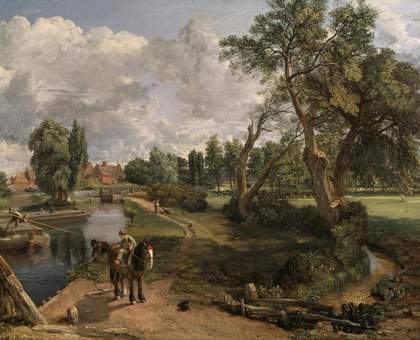
Fig.1
John Constable
Flatford Mill (‘Scene on a Navigable River’) 1816–7
Oil paint on canvas
Support: 1016 × 1270 mm, frame: 1331 × 1583 × 162 mm
Tate
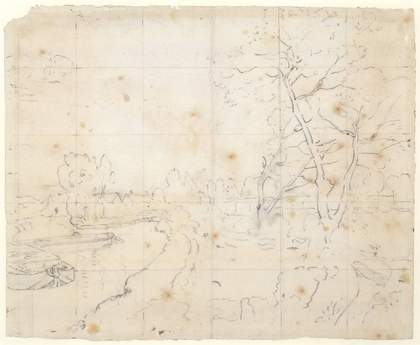
Fig.2
John Constable
Study for ‘Flatford Mill’ c.1816
Graphite on paper
Support: 255 × 312 mm
Tate
Understanding Constable’s interest in the dynamics of visual representation might well explain, for instance, why his painting Flatford Mill (‘Scene on a Navigable River’) 1816–7 (fig.1) diverges from the preliminary drawing (fig.2), the latter having been rendered with the aid of the drawing frame. Constable had traced the outlines of the landscape in paint on his framed glass panel and transferred this by stamping the painted outline onto the reverse of a sheet of paper, which he then traced on the other side by holding the sheet against the light. Art historian Jonathan Clarkson has discussed this drawing, bringing our attention to the fact that several elements in the final painting match exactly with the preliminary sketch.11 However, the composition of Flatford Mill in its totality does not correspond with the outlines of the tracing: the sluice and the dead tree in the middle ground are rendered slightly larger than in the outlines of the preliminary sketch. According to Clarkson this corresponds to impressions of how the human eye focuses, and it is visual tweaks such as these that echo the dynamics of the painter’s and viewer’s eye in Constable’s works, as will be shown below. However, before examining Constable’s perspective studies and his painterly evocation of the dynamics of vision, we must explore Parsey’s unconventional notion of a ‘natural’ or ‘optical plane’ of projection in some detail, and how this intersected with the theories of key predecessors and contemporaries including Noble, George Berkeley and Joshua Kirby.
Parsey’s perspective

Fig.3
Diagram illustrating the visual cone or pyramid
Wikipedia / Public domain
One of the key elements of Parsey’s theory of ‘natural perspective’ saw him contrasting the ‘natural plane’ of vision with the purely mathematically correct, perpendicular section of the visual cone or pyramid, which traditional perspective systems considered as a faithful representation. This cone or pyramid shape was formed by drawing lines that emerge from a point (the viewing eye) and move steadily outwards to encompass the object or objects being viewed (fig.3). When these lines met a surface or plane running perpendicular to them, the resulting intersection would constitute the object’s picture. Yet Parsey criticised the ‘standard idea of the picture plane as a section of the cone of rays’ as it did not depict what was actually seen.12 In his alternative system of perspective, Parsey insisted on the representation of vertical convergence – the phenomenon whereby vertical lines seem to converge dramatically as they move upwards – which standard perspectival constructions avoided even though the effect was noted by some artists when sketching tall buildings.13 He based his approach on visual angles, suggesting the use of ‘chords of the visual sphere located at the base of the upright which denotes the position of the picture’ to establish the apparent, relative lengths of forms.14 By this method, according to Parsey, optical truth instead of merely geometrical truth could be obtained.
Although Parsey was prepared to criticise traditional systems of perspective for the way in which they mistook mathematical for optical principles,15 he did not fundamentally challenge them in the way that the earlier philosopher George Berkeley had. Berkeley, in his Essay Towards a New Theory of Vision (1709), adopted an ‘associative’ approach in explaining how our faculty of sight functions that was in keeping with his sensualist epistemology – an approach to knowledge based on the idea that sensations are the true foundations of cognition.16 With his associative approach Berkeley argued that the visual perception of distance had to be learned like a language, because we cannot gain any idea of distance, magnitude and the position of objects through the faculty of sight alone. Purely visual information that has not been influenced by tactile knowledge is confined to contrasts of light and shade and indefinite, blotchy forms. According to Berkeley, humans can only acquire correct notions of spatial depth and expanses in associating visual data with ideas based on tactile stimuli. True to his sensualist stance, Berkeley retaliated against the then widely accepted geometrical conceptualisation of vision in optics. With his semiotic theory of vision, he rejected the notion of a necessary connection between the visible and the tangible, assuming instead that they were linked only by habit and experience, like words are to their meanings. He argued that the geometrical model of space only illustrated monocular vision and could not explain many phenomena, such as the ability of the eye to counteract lateral distortions at the periphery of our range of vision, which are hard to avoid in pictures based on linear perspective.
Berkeley’s ideas in this area were widely accepted, even if the framework of subjective idealism in which he embedded his new theory of vision was not.17 Many of the scientists and philosophers investigating optics during the latter half of the eighteenth century, including Thomas Reid, William Porterfield and Robert Smith, attempted to reconcile geometric optics with what Margaret Atherton described as Berkeley’s innovative thinking about visual perception in terms of language, ‘associating visual cues with tangible meanings’.18 Parsey’s concept of a ‘true language of the eye’ appears to be a late contribution to such discussions. Yet despite positing an alternative to a purely mathematical conception of space as the norm for visual representation, Parsey’s ‘natural perspective’ does not fit in with the historical departure from the geometric conceptions of optics that took place around 1800, as the art historian Jonathan Crary asserts.19 Crary argues that it was through nineteenth-century art and technology and contemporary techniques of the ‘embodiment of vision’ that the disembodied, atemporal model of visual perception of the seventeenth century became obsolete. However, the studies of philosopher Margaret Atherton and art historian Lyle Massey cast doubt on this assertion.20 After all, the seventeenth-century philosopher and mathematician René Descartes had already warned against equating images on the retina with the things we visually perceive because the physiological correlation between sensations and stimuli is completely unknown to us.21 On the other hand, eighteenth-century medical specialists continued to use geometrical concepts in order to explain the visual effects of their optical experiments.22
Scottish philosopher Thomas Reid, for his part, criticised Berkeley’s semiotic theory of vision, evolving instead the notion of a ‘geometry of pure visibles’ considered today as a first approach towards non-Euclidean geometry.23 Parsey meanwhile adhered to classical Euclidean plane geometry in order to faithfully render natural appearances in image form. As mentioned, his only criticism of traditional perspective systems lay in their idea that the section of the visual cone – which was conventionally perpendicular to the ground in these theories – always produced an image corresponding with natural vision.24
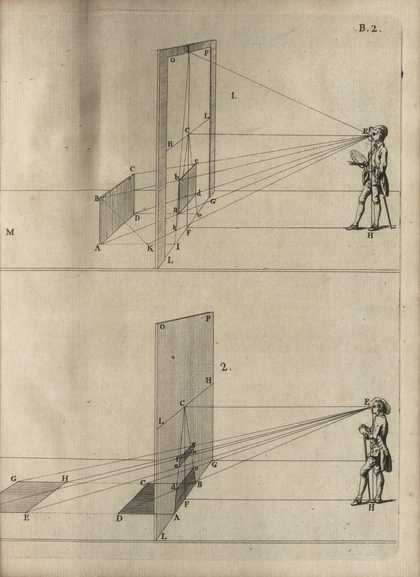
Fig.4
Joshua Kirby
Diagrams depicting the visual rays passing through the picture plane
From Joshua Kirby, Dr. Brook Taylor’s Method Made Easy, both in Theory and in Practice, 2 vols, Ipswich 1754, vol.2, fig.B2
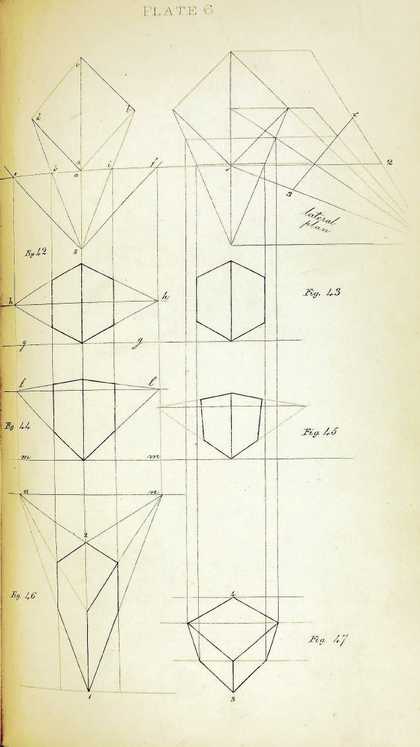
Fig.5
Arthur Parsey
Perspective diagrams of a cube
From Arthur Parsey, The Science of Vision, or, Natural Perspective! Containing the True Language of the Eye, London 1840, figs.42–7
The traditional understanding of perspective was presented by painter Joshua Kirby at the beginning of the second volume of his book on mathematician Brook Taylor’s perspective method, Dr. Brook Taylor’s Method Made Easy, both in Theory and in Practice (1754).25 Kirby was one of the less theoretically minded authors who adopted Taylor’s new terminology and made his theories more accessible to the broader public. Following the traditional system of linear perspective put forth earlier by fifteenth-century humanist Leon Battista Alberti, Kirby depicts the ‘visual rays’ as being able to pass through the picture plane, thus demonstrating how the image of a rectangle is defined as the place where the visual pyramid and the picture plane intersect (fig.4).26 According to Parsey, however, the perpendicular section of the visual pyramid represents the optical plane of vision only in exceptional cases – namely when the eye is positioned exactly opposite the centre of the object being looked at. Diagrams 42 and 43 in Parsey’s perspective diagrams of a cube are examples of this rare coincidence (fig.5), whereas the traditional system of perspective in all other instances produces distorted views. Parsey illustrates this in diagrams 44 and 46, in which the point of sight in both cases lies above the centre of the cube. The distortions resulting here are effectively contrasted with the views on the right side of the page (diagrams 45 and 47) that have been constructed using Parsey’s so-called ‘optical sections’. In these optical sections, the parallel vertical lines of the cube converge increasingly as the point of sight is raised.
The vertical foreshortening is the result of an inclined projection plane, and this is the key characteristic of Parsey’s allegedly ‘natural perspective’. But his theory was not as innovative as he claimed it to be.27 The effects resulting from an inclined projection plane had already been discussed in mathematical theories of perspective, such as those of Brook Taylor. Indeed, the only element of Parsey’s theory that seems to be original is his somewhat unusual opinion that artists are not able to choose at will the exact tilt angle of the projection plane, but instead are dependent on the spatial constellation of the viewed objects.
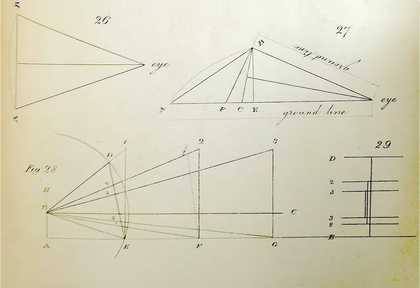
Fig.6a
Arthur Parsey
Diagram showing the significance of the central visual ray
From Arthur Parsey, The Science of Vision, or, Natural Perspective! Containing the True Language of the Eye, London 1840, figs.26–9
Parsey’s discussion of the fundamental significance of the central visual ray, which diagram 26 (fig.6a) shows dividing into two the visual angle encompassing the line AB, is also in keeping with classical perspective theories. Alberti had already pointed out that sharp focus in vision is only possible at a single point that corresponds with the central visual ray of the observer’s eye.28 By referring to contemporary treatises on optics, Parsey came to the conclusion that visual perception was processual by nature, because an object has to be ‘scanned’, so to speak: ‘Although indirect rays enter the sight, th[e] concentrated spot [of the central ray] is the whole space we see truly at a moment; … all the rest [of the rays] are indirect and scatter only an imperfect or faint impression; and to trace a form, the direct ray must be passed over the whole outline.’29 Even though he speaks thereafter of the ‘action of the eye’, the effects of this are regarded as involuntary, ‘being a natural action of the sense over which we have no control’.30 In fact, as mentioned above, Parsey was keen to make it clear that the direction and angle established by the central line of vision could by no means be chosen at will:
The direction [of the axis of vision] cannot be a matter of choice … [T]he choice or will can only direct our sight to such object or objects as we may wish to contemplate on or represent. Having done that, the combination of circumstances contains an axis, which is created by them, and not by our will or choice. The eye does not make the axis of the view, but the objects which make pictures or appearances upon it.31
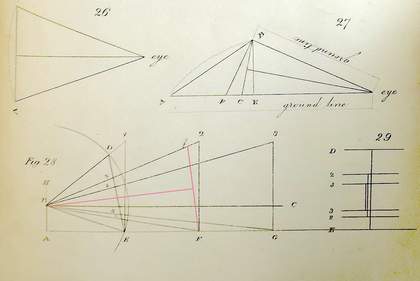
Fig.6b
Arthur Parsey
Diagram showing how the optical projection plane’s inclination is associated with the direction of the axis of vision
From Arthur Parsey, The Science of Vision, or, Natural Perspective! Containing the True Language of the Eye, London 1840, figs.26–9, with pink highlights added to fig.28 by the author
Parsey’s diagram 28 makes this rather cryptic assertion easier to understand (fig.6b). It demonstrates how the direction of the respective ‘axis of vision’ differs between optical projection planes ED and Ff. For Parsey, the assumed angle of tilt specific to each optical plane resulted from the human eye’s natural propensity to counteract distortion as much as possible. He called this adjustment ‘the universal rule of equalisation’; that is, a general principle of distortion rectification.32 Diagram 28 demonstrates the geometry that Parsey presumed to be behind this principle. For clarity’s sake, let us pretend that the illustration represents three equidistant poles positioned roughly one behind the other. The diagram therefore offers a side view of the arrangement, and in it the eye is situated at point B. Diagram 29 illustrates the same constellation of poles seen from the front. In a first test arrangement, which I have highlighted pink in diagram 28 in fig.6b, Parsey requests of his readers that they ignore the first pole E1. Instead the eye should focus on pole F2 by registering its height via two visual rays.
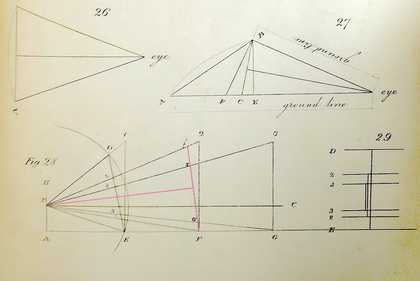
Fig.6c
Arthur Parsey
Diagram representing Parsey’s ‘universal rule of equalisation’
From Arthur Parsey, The Science of Vision, or, Natural Perspective! Containing the True Language of the Eye, London 1840, figs.26–9, with pink highlights and black lettering added to fig.28 by the author
Parsey then postulates that the eye counteracts distortions by slanting the optical projection plane to Ff so that the central visual ray halves the angle of vision. Pole G3, which is the next one along from F2, would be represented as G’3’ within the optical picture plane Ff (fig.6c).
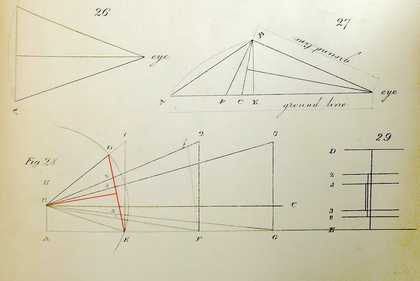
Fig.6d
Arthur Parsey
Diagram indicating how the eye, in jumping to the closest pole, establishes a projection plane at a different angle to the plane of the next pole along
From Arthur Parsey, The Science of Vision, or, Natural Perspective! Containing the True Language of the Eye, London 1840, figs.26–9, with red highlights added to fig.28 by the author
However, as soon as the eye shifts its focus by jumping to the first, closest pole, E1, the apparent length of the two poles would change according to Parsey’s system (fig.6d). The new focus would prompt the eye to establish the projection plane ED, highlighted red in fig.6d, with the result that the optical plane’s angle of tilt would be noticeably different to the one produced by the eye at F.
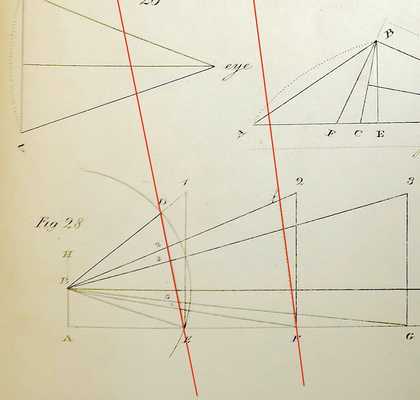
Fig.6e
Arthur Parsey
Diagram showing that the two new projection planes are not parallel to one another
From Arthur Parsey, The Science of Vision, or, Natural Perspective! Containing the True Language of the Eye, London 1840, figs.26–9, with red highlights added to fig.28 by the author
However, by focusing on the closer pole and thus creating a much more tilted optical projection plane, the image of F2 in the projection plane ED is not only smaller. If a broader object and not just a pole were concerned, we would be able to see that the perspectival form of the image of the object would change. This is owing to the fact that the two imaginary projection planes are not parallel to one another (see the red lines in fig.6e). The transformation of optical form as a result of increasingly tilted projection planes can be studied in Parsey’s cube diagram illustrated earlier (fig.5), in which diagrams 43, 45 and 47 are constructed using his new method. Parsey emphasised, while referring to his experiences as a drawing teacher, ‘that it is often a matter of surprise to students in perspective, that objects appear and are represented differently in combination to what they are when represented disconnectedly.’33
Parsey’s hypothesis on the varying optical projection plane, and his idea that a geometric principle determines the position and the exact angle of the inclination of this plane, are very unusual. As a result, the author was not taken seriously by his contemporaries.34 Although in many ways his deliberations drew on the optical and medical discourse about the mechanism of the eye, ‘his attempt to introduce a radically new physiology for the eye, in which the iris becomes the “seat of vision”, hardly helped his case’, as art historian Martin Kemp writes.35
In the eighteenth century the focusing properties of the eye had generally been discussed in conjunction with the phenomenon of sharp and blurred vision. Physician and natural philosopher William Porterfield coined the term ‘accommodation’ for this phenomenon, which describes the ability of the eye to see clearly across different distances.36 The accommodation ability of the eye was discussed, in keeping with James Jurin’s medical theories, in some treatises on perspective that were printed in the second half of the eighteenth century.37 Jurin assumed that the lens of the eye could change its form and thereby adjust its focal point so that an object at different distances to the eye can be seen clearly.38
Parsey’s lengthy speculations about the physiological mechanism of the eye are rather elusive.39 He thought that the crystalline lens reflects light and thus ‘refracts the image upon the posterior plane surface of the Iris’, provoking a ‘re-action … on the Iris’. As a result, Parsey concluded that the iris was the seat of vision, and the locus where the transition from the physical to the mental took place.40 His remarks do not elucidate where his optical plane of projection should be localised and how the varying of its inclination could be achieved. Instead he stressed that ‘we are not treating of the abstract principles of the materials, which produce them [the optical effects], but of the principles of those effects themselves.’41
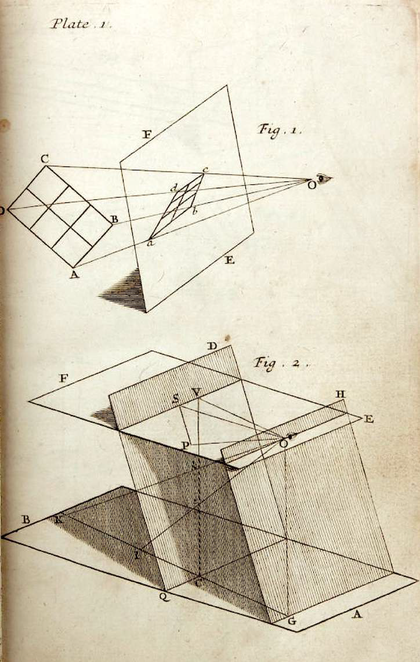
Fig.7
Brook Taylor
Demonstration drawings featuring inclined picture planes
From Brook Taylor, Linear Perspective, or A New Method of Representing Justly All Manner of Objects as they Appear to the Eye in All Situations, London 1715, pl.1, figs.1–2
Parsey did not reveal the sources that inspired him to develop his peculiar ‘universal rule of equalisation’, but the central characteristic of his theory – the inclination of the projection plane – had begun to be discussed in greater detail more than a century earlier following the publication of Taylor’s mathematical introduction to perspective theory, Linear Perspective.42 However, it had been presented rather tentatively in practical works on perspective and the discussion was not linked to the accommodation of the eye but to the question of whether the pictorial space had to be brought in line with the way that a painting is presented to a viewer. As a mathematician, Taylor always worked with inclined picture planes in his demonstration drawings to prove the general validity of his perspective theory (fig.7).43 Kirby, in presenting Taylor’s theories and terminology to a broader public, emphasised that generally the perpendicular plane was used by artists, reflecting the situation in which the picture was later to be placed and viewed.44 While Kirby acknowledged that a picture could be set either perpendicular, parallel or inclined in relation to the ground, overall he considered Taylor’s discussion of the inclined picture plane ‘as rather more curious than useful’.45
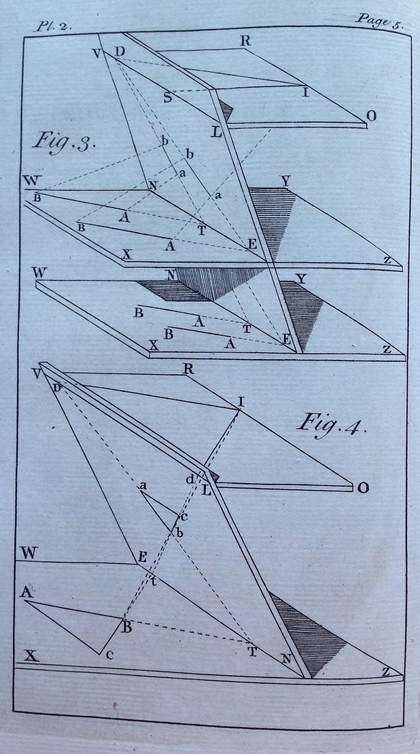
Fig.8
Edward Noble
Diagram adopting Brook Taylor’s use of the inclined picture plane
From Edward Noble, The Elements of Linear Perspective Demonstrated by Geometrical Principles, and Applied to the Most General and Concise Modes of Practice, London 1771, p.5, pl.2, figs.3–4
However, not all writers who undertook the popularising of Taylor’s mathematical theory succumbed to this traditional concept of the picture plane as perpendicular to the ground. Edward Noble, in his 1771 treatise The Elements of Linear Perspective Demonstrated by Geometrical Principles, adopted Taylor’s consistent use of the inclined picture plane (see, for instance, the diagrams in fig.8). The third illustration in Noble’s treatise presents a general view of the concepts of the horizon line and the vanishing point, which are key features of Taylor’s method (see diagram 3 in fig.8). The representation is designed to indicate that all visual planes lying parallel to one another, if infinitely long, will converge into one line: their horizon line. All parallel lines intersect at the horizon line because they converge at the same point, known as the vanishing point.
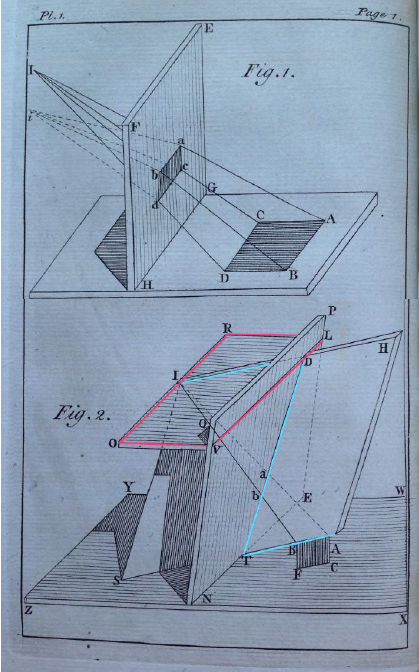
Fig.9
Edward Noble
Diagram contrasting Brook Taylor’s diagrams with conventional depictions of perspective
From Edward Noble, Elements of Linear Perspective, London 1771, p.1, pl.1, figs.1–2, with red and blue highlights added to fig.2 by the author
Noble’s diagrams palpably illustrate the geometric principles that determine a perspective view. Like Taylor’s, these diagrams are unusual in that they illustrate perspective in the shape of cardboard models, rather than purely with lines, in order to more clearly demonstrate how spatial constellations are constructed on the pictorial plane in terms of geometric relationships. Perspective construction manuals seeking to teach artistic practices based on the concept of the planar section of the pyramid of vision do not show such geometric relationships. As Noble demonstrates by contrasting the two methods of representation in his first two illustrations (fig.9), the visual planes containing the construction lines, labelled OVLR, SAHI and NEPQ in the second diagram, are normally not displayed. Technically, however, they are necessary for locating the vanishing point of a foreshortened line because, in Noble’s phrasing, they establish the ‘ideal direction’ of such a line. The second diagram in fig.9 shows how the intersecting visual planes, which connect the position of side BA of the square to be depicted with the eye of the beholder at I, determine the position of the vanishing point D on the horizon line VL, thus establishing the direction of the depicted line ba on the pictorial plane. In this way Noble’s diagram renders visible the geometrical reasoning that provides the basis for the construction methods of perspective views.
The drawing frame
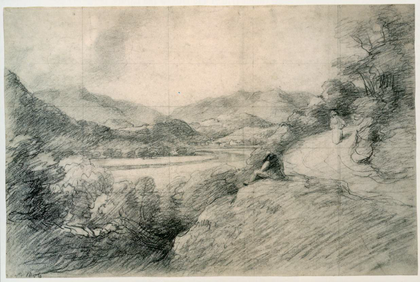
Fig.10
John Constable
The River Brathay and the Village of Skelwith Bridge, ‘[?7] Sep.r 1806’ 1806
Pencil on paper
247 x 373 mm
Private collection
Considering the theoretical aspirations of Edward Noble’s treatise on perspective, it might come as a surprise to us that evidence exists of Constable having actually studied the work. The auction catalogue listing the books belonging to Constable that were sold after his death reveals that he owned a copy of ‘Noble’s Perspective’.46 Admittedly, two authors sharing the surname Noble had published treatises on the topic at the time, an Edward and a Thomas. While Thomas Noble addressed prospective landscape painters and offered a purely practical, generously illustrated introduction to perspective in his Practical Perspective, Exemplified on Landscapes (1805), Edward Noble’s treatise pursued a thorough investigation and understanding of the theory and methods of perspectival representation.47 Three drawings that Constable executed during a six-week sojourn in the Lake District in September 1806 strongly suggest that it was Edward’s treatise that he studied: these are The River Brathay (fig.10), Glaramara and Derwentwater.48 Art historian Ian Fleming-Williams has drawn attention to the seemingly arbitrary grid in these drawings, describing the irregular structure with which Constable divided up the sheet before beginning each one. The grid is barely visible in the view of Derwentwater, whereas River Brathay and Glaramara hardly disguise it, rendered as it is with a harder pencil.49
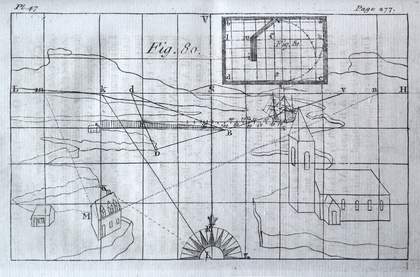
Fig.11a
Edward Noble
View with a drawing frame
From Edward Noble, Elements of Linear Perspective, London 1771, p.277, pl.47, figs.80–1
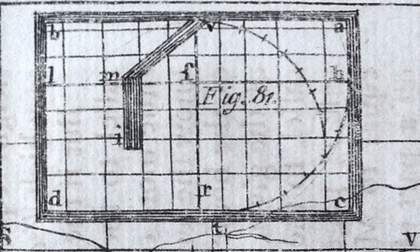
Fig.11b
Edward Noble
Detail of fig.11a showing the drawing frame
The peculiarity of Constable’s grid in these drawings, with its segments becoming larger the further they are from the point of sight, might well be a reference to Edward Noble’s recommendations for the construction of a drawing device for depicting landscapes: ‘A simple Apparatus for taking extensive views with certainty and propriety’, as Noble described it.50 In his treatise Noble illustrates a view that has been made with the assistance of this drawing frame device, which is depicted at the top edge of the composition (fig.11a). The device consists of a wooden frame with L-shaped handle, which in the sketch has been marked with the points v (top centre), m and i (both centre left) (fig.11b). The L-shaped handle was attached perpendicularly to the top of the frame. At point i on the handle there is a small hole through which the viewer was to fix their gaze, thus defining the position of the eye in real space geometrically. The point labelled f represents this point of sight in the picture plane. Fine threads would then be pulled through small holes in the wooden frame to produce the grid, subdividing it into angles of vision.

Fig.11c
Edward Noble
View with a drawing frame, with red highlights added by the author showing how the arcs are divided into eight equal sections
Noble describes step by step the construction method for his grid. The distance from the point of sight (i) to the picture plane (f), that is if, determines the radius of two arcs, which are visible in Noble’s diagram in the right-hand portion of the frame. The frame’s upper and right edges (ab and ac) are used as tangents for these arcs, with their centres at different points. The next step comprises dividing up the arcs into eight equal parts – visible in the diagram as a series of short vertical lines drawn onto each arc. The drawing grid is then produced by linking the arcs’ centres with their respective eight dividing points, thus mapping out their radii (the distance from the centre to the arc), and then extending the resulting construction lines up to the edge of the frame (see the red lines in fig.11c).
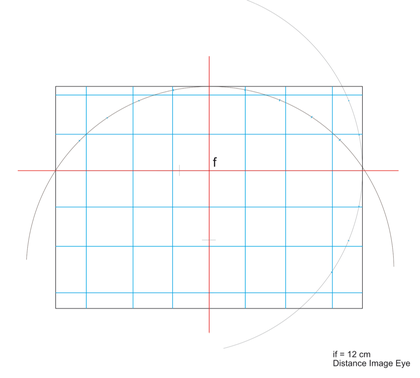
Fig.12a
Diagram showing how a short distance between the eye and the picture plane results in a broad view, with f representing the point of sight in the picture plane
Author’s drawing
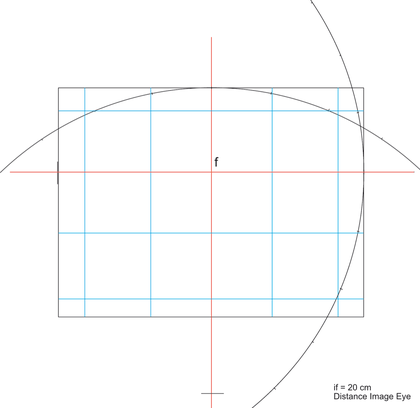
Fig.12b
Diagram showing how a longer distance between the eye and the picture plane results in a zoom effect, with f representing the point of sight in the picture plane
Author’s drawing
The same procedure is carried out on the drawing sheet. Here Noble emphasised that for this purpose the length of the arc’s radius can be chosen at will, ‘which, by this means, becomes the distance of the picture’.51 Choosing a short distance from the eye to the picture plane generates a broad view (fig.12a). An increased one produces a kind of zoom effect (fig.12b), as the view now spans only a small section of the one that is visible within the wooden frame for the draughtsperson to translate to their drawing paper by the help of the grid. Of course, the fragmentary view can be compensated for by simply selecting a larger sheet of paper. The choice of distance to the picture plane, then, simulates the effects different distances of the eye to the drawing frame would have while peering through it: the closer the eye moves to the frame, the larger the angle of vision and the field of vision. This phenomenon can be compared to the zoom and wide-angle function of a modern camera.
Noble’s grid is subdivided in a way that corresponds with the angles of vision, such as can be found in quadrants or astrolabes, which are tools used to measure the angle of elevation of an object in relation to the viewer. One quarter of our range of vision (represented by one arc) has been divided up into eight equal angles, such that together these eight segments represent a 90° section in the grid.52 This aids the draughtsperson in establishing the vanishing points of an object on the horizon line of the drawing frame. For instance, it is relatively easy to determine the location of the right-hand vanishing point of the house in the foreground in Noble’s landscape (see the house marked M in the lower left corner of fig.11a), as the gutter around the foot of the roof makes it more obvious. But it is more difficult to ascertain the location of the vanishing point on the left-hand side of the house. As the structure of houses is based on right angles, we can, assisted by Noble’s grid, simply count off eight segments from the vanishing point on the right-hand side denoted n and thus find the vanishing point we are looking for on the left-hand side at m.
Noble’s drawing device seems to be small and practical in comparison to painter and printmaker Albrecht Dürer’s more famous perspective frame, devised in the early sixteenth century.53 If we were to place Noble’s handle against our forehead and peer through its sights while moving our head in unison with the frame in different directions, we would become aware of how even the vertical lines of a relatively close, tall building converge as soon as we raise or lower our heads slightly. We already encountered such converging vertical lines in Parsey’s treatise, and they are particularly pertinent in their relation to the grid of the drawing frame. We can therefore perhaps best compare the device with the viewfinder of a camera, which likewise acts as a support for internalising the rules of perspective. At the same time, a defect of central perspective representation can be clearly seen toward the edges of the divisions in Noble’s grid, where the segments become larger: an effect that sixteenth-century artist and mathematician Leonardo da Vinci had discussed as lateral distortion at the edges of the representation that appear when the angle of vision is relatively large.
Advice for artists
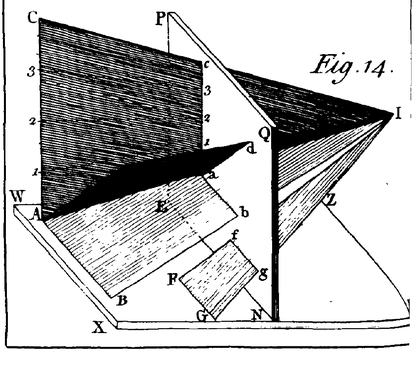
Fig.13
Edward Noble
Diagram showing how each line within the range of vision can be embedded in a visual plane that intersects with the picture plane
From Edward Noble, Elements of Linear Perspective, London 1771, p.39, pl.9, fig.14
The portable format of Noble’s drawing frame, together with the diagrams in his treatise, allowed it to function as an artist’s aid for acquiring an intuitive understanding of the geometrical relation between actual space and a perspectival depiction of it. Instead of merely offering a manual of perspective construction methods, Noble’s treatise taught the artist to think in terms of visual planes. For example, in diagram 14 of his publication (fig.13) Noble shows how each line within the range of vision can be embedded in a visual plane that intersects with the plane of the picture, thus revealing the represented line’s direction towards its vanishing point. In a different way to Taylor, Noble emphasised the significance for artists of the horizon line and with it the corresponding horizontal plane, which is highlighted in red in the second diagram of Noble’s treatise (see fig.9). Noble states of this:
For although this plane and line, as Doctor Taylor observes, does not enjoy any particular advantage more than any other original plane and its vanishing line, in regard to the theory of perspective; yet gravity has made it and its parallels of so much consequence in the disposition of nature, that a picture can no more be drawn without a horizontal line, than a geographical map can be constructed without fixing the position of the first meridian.54
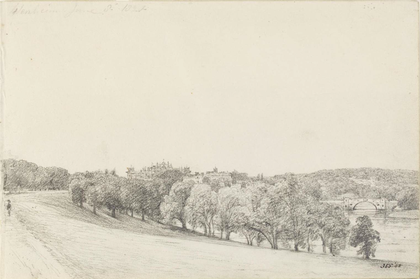
Fig.14
John Constable
Blenheim Palace and Park, Woodstock 8 July 1821
Pencil on paper
173 x 261 mm
Victoria and Albert Museum, London
The drawings from Constable’s sketchbooks of the 1820s are paradigmatic for the way in which he could visually grasp complex spatial situations. It was especially useful when confronted by hilly landscapes to comprehend a landscape abstractly, as if it were made up of various inclined visual planes, in order to acquire an exact idea of where these planes intersect with the picture plane. Among Constable’s drawings that demonstrate this is a view of Blenheim Palace in Oxfordshire from 1821, in which the highly sophisticated composition displays the palace nestled serenely in the centre amid extensive parkland, hidden behind majestic trees (fig.14). The drawing conveys the expanse of the park and the length of the path as it sweeps in an extended curve to the palace, offering manifold picturesque views on the way. Constable chose an eccentric ‘point of station’, or viewpoint; it lies roughly opposite the stone bridge on the right-hand side of the scene. Even the tiny figure on the left-hand side of the drawing, gazing beyond the edge of the composition and providing a counterpoint to the bridge, would have been quite far removed from the draughtsman. On a purely formal and aesthetic level, the bridge forms the first focal point, attracting the viewer’s attention immediately. The figure, which is situated at a distance somewhere between the artist and the bridge and marks the middle ground of the view, functions as a sort of second focal point. However, it also draws the gaze into the distance to the palace, which is the thematic centre of the drawing, despite being barely visible. The outcome of this tension between the formal and the thematic is a high degree of visual dynamism in the scene, which evokes the expansive surroundings and the many allurements that they offer to the casual stroller.
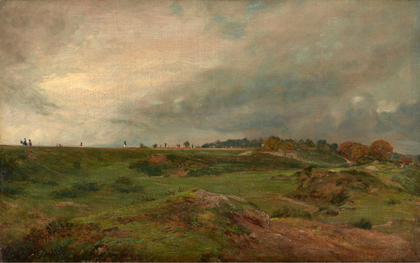
Fig.15
John Constable
A Road Across Hampstead Heath c.1822
Oil on canvas
327 x 502 mm
Yale University Art Gallery, New Haven
Constable demonstrated these powers of spatial comprehension especially well in his sketches and studies of the landscape of Hampstead Heath, London, in the way he rendered the ridges and the many small sand hills and furrowed depressions – see, for instance, A Road Across Hampstead Heath c.1822 (fig.15). Whereas Noble underscored the great significance of the horizon line for the organisation and cogency of spatial situations in his treatise, Constable played with the perspective geometry in A Road Across Hampstead Heath by arranging the ridge path in the background parallel to the picture, and leaving the horizon, situated at a lower point, behind it and therefore not visible.
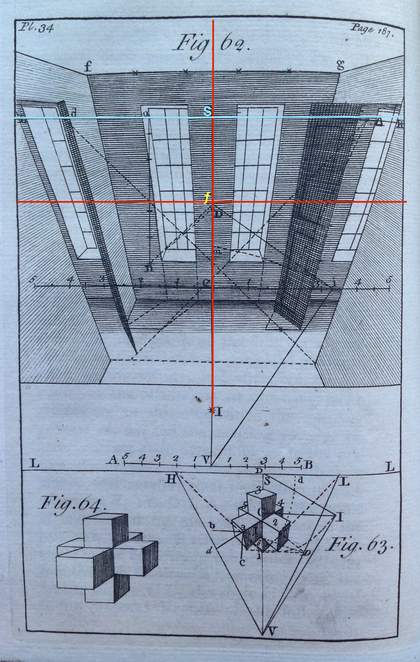
Fig.16
Edward Noble
Diagram showing how, if the picture plane is tilted forward towards the ground, the ‘true’ horizon of the landscape is situated higher up
From Edward Noble, Elements of Linear Perspective, London 1771, p.187, pl.34, figs.62–4, with red, blue and yellow highlights added to fig.62 by the author
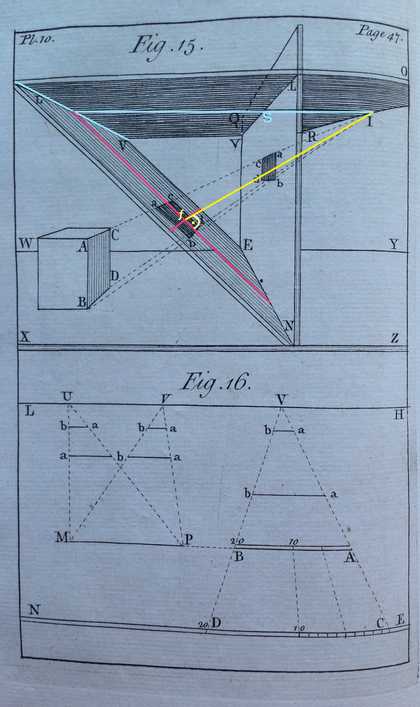
Fig.17
Edward Noble
Diagram showing the geometrical relationship between the ‘true’ horizon and the horizontal line at eye level
From Edward Noble, Elements of Linear Perspective, London 1771, p.47, pl.10, figs.15–16, with red, blue and yellow highlights added to fig.15 by the author
In his treatise on perspective, Noble elucidates the function of the horizon line in a number of illustrations. While the horizon of the landscape is on par with the eye level of the drawing frame when it is held upright in relation to the ground, these two lines diverge as soon as the picture plane – that is, the drawing frame – is tilted. If the picture plane is tilted forward towards the ground, the ‘true’ horizon of the landscape is situated higher up. Noble demonstrated such a downward view in diagram 62 (fig.16), having explained the geometric rules of such a view in diagram 15 (fig.17). If the frame in diagram 15 were in an upright position, the lines marked blue and yellow (representing the line of sight) would coincide, and thus also the true horizon (blue) would coincide with the horizontal line at eye level, which is marked red.
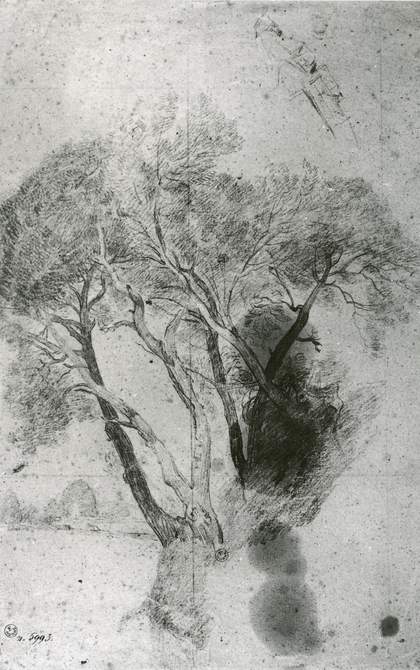
Fig.18a
John Constable
Trees at Flatford 1813
Pencil on paper
470 x 291 mm
Horne Museum, Florence
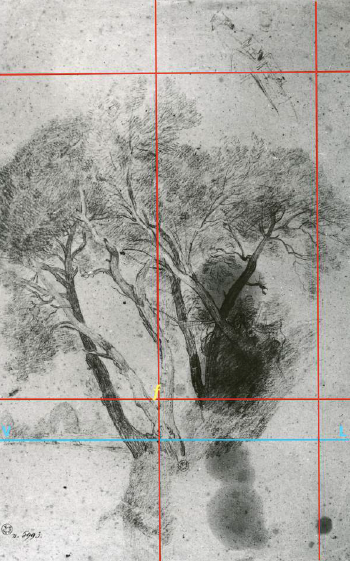
Fig.18b
John Constable
Trees at Flatford 1813, with red, blue and yellow highlights added by the author to show the position of the true horizon and of the horizon line of the drawing frame’s grid
The barely visible grid in Trees at Flatford, sketched in 1813 (figs.18a and 18b), suggests that Constable experimented with sloping picture planes. Constable seems to have directed the eye upward, so that the ‘true’ horizon (again highlighted blue) of the landscape lies below the horizon line of the frame’s grid (highlighted red) that marks the direction of the gaze. It is difficult to ascertain the exact function of the drawn grid as the drawing only reveals a small section of it, and it is of course feasible that Constable simply used the grid for transferring the drawing.55 However, a landscape view like Constable’s drawing, which unites in one view the base of a tree trunk, the entirety of its branches and leaves, and the trees far in the distance close to the horizon, seems improbable without shifting the gaze upward and thus inclining the picture plane.
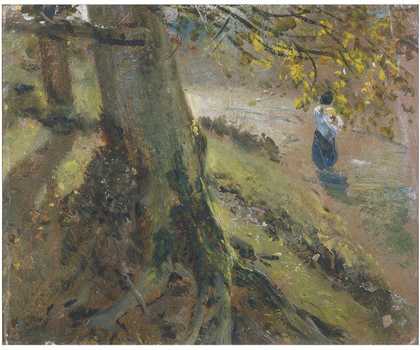
Fig.19
John Constable
Study of Tree Trunks c.1821
Oil on paper
248 x 292 mm
Victoria and Albert Museum, London
Constable’s Study of Tree Trunks (fig.19) is the most obvious candidate for a discussion of how he experimented with a slightly inclined picture plane. The oil sketch is dated c.1821 and demonstrates the artist’s downward gaze as he stood to the right of the large tree on elevated ground, gazing from behind the tree and down to the foreshortened figure of a woman. When sketching the scene Constable placed himself opposite this figure, such that it is arranged vertically towards the right edge of the sketch, whereas the trees to the left seem vertically distorted and tilted towards the viewer. This study displays Constable’s strong sense for spatial relations even in complex compositions.
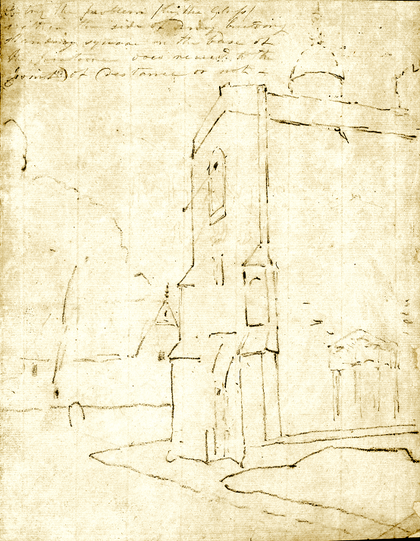
Fig.20
John Constable
East Bergholt Church 1814
Pencil on paper?
251 x 194 mm
Staatliche Graphische Sammlung, Munich
However, Parsey seems to have been correct in assuming that Constable had not fully understood the principle of his drawing frame. At some point Constable replaced a string grid with a glass panel, such that the outlines of the view could now just be traced through the glass.56 While experimenting with perspective using the framed pane of glass, it appears that Constable was confused by the phenomenon in which parallel lines converge in perspective. A comment written by the artist on a tracing of the church porch at East Bergolt from 1814 (fig.20) seems to hint at this: ‘To try the problem (by the Glass) whether the side of any building standing square on the base of the picture does recede to the point of distance or not.’57 In this drawing Constable evidently wished to test the verity of Noble’s claim that, in perspective view, all parallel lines, even the verticals, converge at their vanishing point. While the parallel lines formed by the top and bottom of the front facade meet at a vanishing point at the left, it is more difficult to find the vanishing point of the church roof’s gutter. This is not only a result of the sketchiness of Constable’s drawing and the complex geometry of the picturesque old church porch, but also of the fact that the vanishing point on the right is situated far beyond the edge of the depicted scene. Constable’s drawing frame and thus the picture plane were positioned almost orthogonally (at right angles) to the ground so that the vertical lines of the church hardly converge. In addition, he seems to have arranged the drawing frame parallel to the facade of the building standing behind the church.
Carefully aligning his views with the orthogonality of the picture plane is characteristic of Constable’s landscape drawings and paintings. He only deviated from this principle in exceptional instances. Such an alignment conformed to aesthetic expectations because paintings were (and still are) normally viewed hanging on walls, and thus perpendicular to the ground. The primacy of this format is emphasised by Kirby in his criticism of Taylor’s discussions on inclined picture planes.58 The reality was that painters could not reproduce their actual experiences of landscape scenery if they were to adhere to such mathematical models and devices in depicting them: while sketching and painting scenes they were in fact inundated by a multitude of successive views unconnected to the rigid orthogonal frame of reference of the pictorial field.
Constable was acutely aware of these contradictory demands of nature and art, as he revealed in a description of an excursion to Devil’s Dyke, a deep valley north of Brighton, in an 1824 letter to his friend John Fisher. He praised the countryside there as being:
perhaps the most grand & affecting natural landscape in the world – and consequently a scene most unfit for a picture. It is the business of a painter not to contend with nature & put this scene (a valley filled with imagery 50 miles long) on a canvas of a few inches, but to make something out of nothing, in attempting which he must almost of necessity become poetical.59
From an artistic viewpoint, then, it is not just a case of extracting a single and thus chance scene out of the continual flow of perception. Even if this single image so quintessentially corresponds with a snapshot of what is actually experienced, it cannot evoke the sublime feelings that a hike at Devil’s Dyke would incite, continually presenting dramatic views owing to its strikingly steep slopes.60
The letter Constable sent to Fisher reveals his great awareness of the degree to which visual perception is construct-based. It is a complex and synthetic process involving not only visual sensations but also knowledge gained through experience; for example, through moving around in a three-dimensional environment and through the sense of touch. Related topics were addressed by several authors of treatises on perspective towards the end of the eighteenth and in the early nineteenth century.61 Perspective theorists who were interested in the correct geometrical representation of space nevertheless held on to the idea of a painting representing a single viewpoint at a particular moment in time. Parsey, too, did not challenge this fixed notion of a picture, even if his treatise tried to determine the geometry of focus and thus the dynamics of the eye.
Vision and time
In light of the new theories of visual perception that emerged in the course of the eighteenth century, which discussed the eye’s manifold movements and accommodation ability, the ‘moment’ of a pictorial representation was, in theoretical terms, reduced to a fraction of a second. This led to a conflict between the mechanistic conception of time in representation, in which the point in time is regarded as fixed, and the traditional contemplative notion of an image, in which time is conceived as fluid. Most prominently, the writer and philosopher Gotthold Ephraim Lessing acknowledged the potential for such a conflict in his treatise Laocoon: An Essay upon the Limits of Painting and Poetry (1766).62 Proponents of the new physiological conceptualisation of sight began challenging the concept of the fertile or pregnant moment, which continued to assert its validity for history painting into the early nineteenth century via the theoretical writings of Joshua Reynolds and Henry Fuseli.63 In A Notion of the Historical Draught, or Tablature, of the Judgment of Hercules (1714) the Third Earl of Shaftesbury argued against the simultaneous representation of successive events in one tableau as this would undermine the painting’s pictorial truth and contradict the ‘Rule of the Unity of Time’.64
Landscape painters striving towards naturalism, such as Constable, embraced the challenge of the new physiological comprehension of the visual processes of perception. As can be seen in Constable’s response to the complex nature of the landscape at Devil’s Dyke, the artist was sensitive to the singular and unnatural effects of representing a single moment because this would be contrary to how nature is experienced and how the beholder gauges the ‘truth’ of a landscape painting. Such ideas left their mark at least on Constable’s preliminary studies, in his plein air and pencil sketches, which to a degree preserve the impression of being taken directly from nature, not only through the artist’s use of unusual viewpoints but also in his continual stimulation of the beholder’s eye through the subtle direction of light and through his sketchy handling. Instead of a single moment not unlike the snapshot in photography, Constable created with his views what might be called ‘continuous moments’. To this end he developed strategies for reconciling the demands of geometric perspective with his own ambitions of conveying to viewers a feeling for the synthetic nature of visual perception and its dynamics.65 To subtly motivate spectators to move as they looked at a painting, Constable deliberately experimented with the spatio-pictorial organisation of his compositions, exploiting the ambiguities of the third dimension that accompany perspectival depiction.66 He did so despite the fact that Edward Noble warned against such a lack of clarity with regard to the position of the beholder in a composition.
Like Kirby before him, Noble referred to the quick succession of an uncountable number of perceptual images that form the basis of our visual experience and the role that moving our bodies plays in our understanding of space.67 He emphasised the difference between the purely visual appearance of an object and the knowledge of its actual spatial disposition, which he specified was the result of synthetic experience.68 As is shown in his investigation into how we acquire comprehensive spatial understanding of objects when perceiving them by means of vision alone, Noble was conscious of the ambiguity that arose when perspectival representation made an object look unlike itself from some angles. A composition was to avoid such ambiguities at all costs, and Noble reminded his readers that in real space we intuitively position ourselves parallel to the object, ‘Because by that means, the picture on the retina, will be similar to the object we contemplate.’69 Noble therefore urged painters to always adopt the point of sight that a beholder would intuitively occupy in the field: ‘For then the picture will always be seen with advantage, and will convey at first sight, the idea which the artist intended.’70
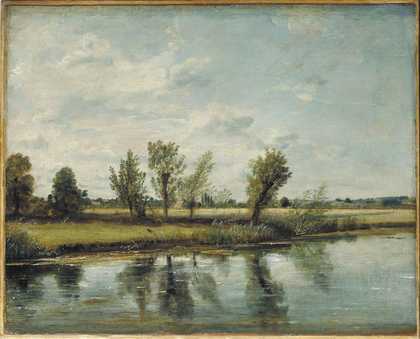
Fig.21
John Constable
Water-Meadows near Salisbury 1820 or 1829
Oil on canvas
457 x 553 mm
Victoria and Albert Museum, London
Contrary to Noble’s advice that it should be evident to viewers where they should position themselves before a painting, Constable sometimes made it difficult for his viewers to find the exact spot for viewing his works. This is particularly the case when rectangular objects like houses are depicted in the far distance, such as in the medium-sized painting Water-Meadows near Salisbury 1820 or 1829 (fig.21), which was exhibited at the Royal Academy Summer Exhibition in 1830. Here, the houses no longer function as spatial reference points because they are close to the horizon. The placement of the vanishing points to the left and right far beyond the frame strengthens the feeling that the viewer could go for a walk along the river flats. To a degree, the painting conveys the experience of great expanse that might be felt when moving through a landscape of this kind. Constable intentionally decided on a low point of station, and with the aid of his framed pane of glass he recorded the spatial situation exactly.71
The divergence between represented and embodied viewpoints can leave viewers in the dark about where exactly the central vanishing point is located – and therefore also about one’s own position in front of a painting. Although ambiguities of this kind are a central aspect of perspective geometry, as Lyle Massey has demonstrated in her analysis of distance point constructions, viewers are especially aware of such ambiguities in the cases where the lateral vanishing points lie far beyond the frame.72 Parsey likewise investigated the divergence between geometry and sight, reminding readers in The Science of Vision that an image only reveals the impressions we receive by means of sight, and not their underlying geometric circumstances: ‘a picture cannot point out the distance between the objects represented and the point of station, because it shews only the effect of seeing and not the connecting circumstances which produce the effect.’73
Constable was adept at taking advantage of such ambiguities and effects. Viewers of Water-Meadows near Salisbury remain uncertain of their exact position because no clues are provided for the exact position of the centric point, which is located somewhere on the left of the painting behind the trees arranged largely parallel to the overall composition.74 Moreover, the lateral vanishing point of the painting subtly draws our attention to the right. The ambiguity resulting from the tension between the relatively small format of the picture and the great expanse of the represented landscape makes Constable’s painting fascinating, despite seeming somewhat unspectacular at first sight. In addition, the ambiguous viewpoint of the beholder can have the effect of subtly inciting them to move around in front of the painting.
In the context of a large public exhibition such as the Summer Exhibition at the Royal Academy, where many visitors would have beheld this painting simultaneously, this seems extremely apt. The aesthetic experience in viewing Constable’s painting – notwithstanding its deliberate naturalism – thus goes beyond merely an experience in nature, encouraging beholders to adopt a reflective distance from the represented scene and to consider the possible implications of its artificial authenticity. This transforms the experience of viewing the painting into a mental endeavour. Given that Constable was confident enough to send this relatively unassuming work to the Summer Exhibition in 1830, one year after his long-hoped-for election as Royal Academician, he may have considered its artistic aspirations in light of Joshua Reynolds’s demand to value a painting not based on the mechanical labour invested in it, but on ‘the mental pleasure produced by it’.75 Constable’s hopes to be acknowledged for the reflective potential of his ‘natural peinture’ were frustrated, however, as is demonstrated by the harsh criticism that the painting met with when it accidentally appeared among the works submitted by non-academicians, prompting the artist to withdraw the work quietly.76
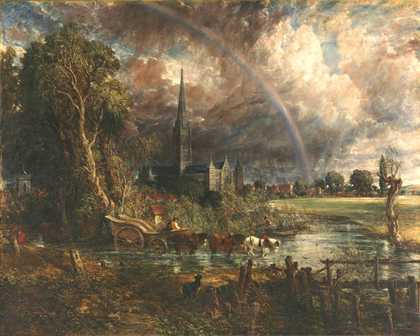
Fig.22
John Constable
Salisbury Cathedral from the Meadows exhibited 1831
Oil on canvas
1537 x 1920 mm
Tate
The perspective lessons of his early years not only informed Constable’s more naturalistic work, but also the ambitious six footers with their more or less disguised symbolism that the artist concentrated on in the years after his election to the Royal Academy.77 In these compositions we often find different focuses of attention reminiscent of Parsey’s description of the dynamics of vision, yet synthesised into one expansive view. In the foreground of Hadleigh Castle 1829 (Yale Center for British Art, New Haven) the gaze is directed downwards by the top view of a seagull darting close to the ground towards the beholder, whose eyes are busied with the weeds painted in some detail next to the rough texture of the ruined wall and drawn to the shepherd with his dog on the left, before the gaze is taken again to the horizon and thus to a frontal view. If the ruined castle is meant to remind the viewer of the brevity of life, the watery horizon gleaming with light may give consolation.78 The strategy to direct the gaze of the beholder in a meaningful way through the image can also be observed in one of the artist’s most ambitious compositions, Salisbury Cathedral from the Meadows exhibited 1831 (fig.22). While exploring the lateral and spatial extension of the landscape, the gaze returns again and again to the centre of the condensed landscape format that is marked by the edge of the north turret of the cathedral’s west front. The western facade of the stair turret forms a kind of visual anchor.79 The cathedral confers stability on a composition characterised by an overabundance of detail and the evocation of incessant movement on the ground and in the sky. The sunlit turret leads the eye to the cathedral’s majestic spire and to a spot in the sky where the tumultuous clouds start to break up. The angular perspective of the cathedral thus evokes expansiveness even though the horizon is blocked by a row of distant buildings and trees. In view of the efforts at socio-political reform that were taking place at the time, and which Constable opposed staunchly,80 the confined view of worldly matters is contrasted with a spiritual one.
